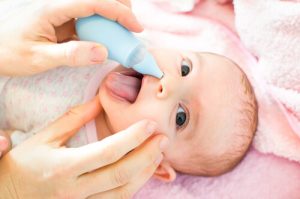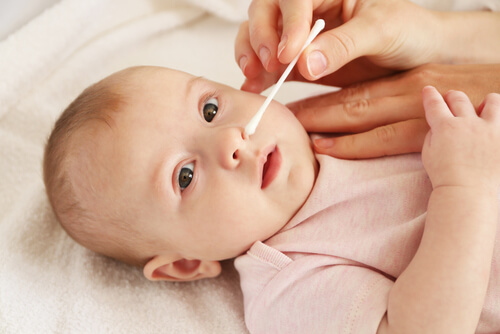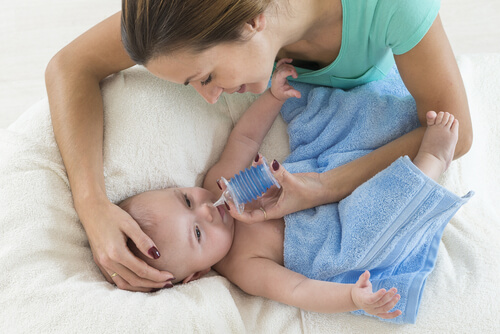Nasal Hygiene in Babies: 6 Key Factors

Because babies are delicate, carrying out tasks as simple as nasal hygiene can be a problem if we don’t know how to perform them correctly. However, it’s all about being careful and trying not to apply force.
Nasal congestion is annoying for everyone. Not being able to breathe well is frustrating and exasperating, especially when it’s time to sleep.
For babies, the issue becomes more complicated since they can’t blow their nose or irrigate their nose by themselves yet.
That’s why it’s important for parents to tend to these tasks for them. This way, their airways will be cleared of the mucus that lodges and clogs there.
When to perform nasal hygiene in babies
Nasal hygiene in babies is recommended when they can’t breathe well due to the mucus that blocks the airways.
With nasal hygiene in babies, we aim not only to help the child breathe better, but also to avoid problems such as sinusitis or otitis, which can develop when mucus accumulates.
These are quite common illnesses in babies.
It’s recommended to perform nasal hygiene in babies before sleeping and eating in order to allow them to sleep and eat without discomfort in their respiratory tract.
Methods to decongest the nasal passages
A recommended method for decongesting babies is to use a humidifier or find a way to humidify the room where the baby will be for a while.
This method is ideal, especially in winter, since heating systems can dry out the airways and make the problem worse.
You can get devices that allow you to hang water on the radiator so that it evaporates. You can also humidify an area by boiling a large pot of water.
Additional recommendations
- Wash your hands well, as this will prevent infections.
- Try to make sure the baby is comfortable in order to avoid frightening him or making him cry.
- Have all the tools on hand in order to carry out the process quickly. The most common tools usually include: saline, a syringe and a nasal aspirator.
- Have a cloth handkerchief or disposable wet wipe on hand in case it’s necessary.
- Be sensitive when handling the baby’s nose.
- Don’t force the baby if he resists.

How to perform nasal hygiene in babies
We must pay close attention in order to get favorable results and keep the baby comfortable.
If your child is old enough to follow directions, instruct him to tilt his head forward over a sink.
On the other hand, in the case of a baby, you must lay him on a soft surface, like a changing table or bed.
Afterward, make sure the baby is still, which is a bit difficult. But you must find a way to make him stay as calm as possible so he’ll avoid getting hurt and feeling uncomfortable.
To ensure the baby doesn’t move, it’s best to have someone help you. But if you’re alone, you can wrap the baby in his blanket to immobilize him.
How to use saline solution
When it comes to nasal hygiene in babies, it’s best to use a physiological serum depending on the intensity of the mucus.
When the baby has a lot of mucus or the mucus is very dense, you should apply the serum drops through the nostrils.
If the baby doesn’t have much mucus or it isn’t very dense, just apply a few drops of saline solution.
To ensure the nasal hygiene in babies is as effective as possible, heat the serum a little before applying it to the baby’s nose.
This makes the liquid less bothersome to the baby, thus making him more comfortable.

Steps to follow for nasal hygiene in babies
- Use a syringe or dropper to drop (or more, depending on the case) into the opening of each nostril. If you do it this way instead of inserting the tip of the instrument into the baby’s nose, you’ll cause less discomfort.
- When the liquid enters the nostril, don’t let your baby open his mouth (gently put pressure on his chin) so he’ll breathe through his nose and expel mucus.
- Don’t directly use a nasal aspirator or irrigator immediately, since the body can expel mucus via its own instincts.
- Use the aspirator only when you notice that the mucus is extremely dense and the baby can’t expel it well enough on his own.
- When you use the aspirator, use it gently and carefully, because if you’re rough you can cause ear injuries or even cause the mucus to reach the ears, creating an infection.
- The most recommended aspirators are the bulb design, because it’s easier to control the suction intensity.
- The “pear” aspirators are in disuse, because they aren’t effective.
All cited sources were thoroughly reviewed by our team to ensure their quality, reliability, currency, and validity. The bibliography of this article was considered reliable and of academic or scientific accuracy.
- Marchisio P., Picca M., Torretta S., Baggi E., Pasinato A., Bianchini S., Nazzari E., Esposito S., Principi N. Nasal saline irrigation in preschool children: A survey of attitudes and prescribing habits of primary care pediatricians working in northern Italy. Ital. J. Pediatr. 2014; 40: 47. doi: 10.1186/1824-7288-40-47.
- Slapak, Ivo & Skoupa, Jana & Strnad, Petr & Horník, Pavel. (2008). Efficacy of Isotonic Nasal Wash (Seawater) in the Treatment and Prevention of Rhinitis in Children. Archives of otolaryngology–head & neck surgery. 134. 67-74. 10.1001/archoto.2007.19.
- How to give our child nose ointment, drops or spray. NHS. Great Ormond Street Hospital for Children (NHS Fundation Trust). [Online].
This text is provided for informational purposes only and does not replace consultation with a professional. If in doubt, consult your specialist.
